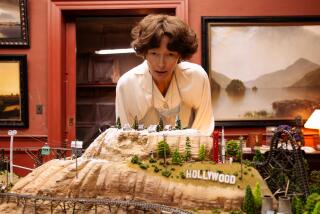MOVIE REVIEW : The Nightmare Comedy of ‘Patty Hearst’
- Share via
To live outside the law, you must be honest --Bob Dylan
In “Patty Hearst” (selected theaters), director Paul Schrader plunges us into the maelstrom, thrusts us into the belly of the beast. But it’s a cool maelstrom, and the beast has an ominous, silly purr. This story, born in terror, quickly reshapes itself into dark hilarity, a nightmare comedy of preposterous proportions.
Oddly enough, it’s as black comedy and social history, far more than thriller or human drama, that “Patty Hearst” works best.
The movie is based on Hearst’s own account of her infamous case: her abduction in 1974 by a ragtag revolutionary group, the Symbionese Liberation Army, who held her for ransom by her father, heir to the Hearst journalism empire; her brainwashing and involvement in several robberies; her flight after most of the SLA died in a police shoot-out; her arrest and trial. Schrader gives us the action through Patty’s eyes, trying to duplicate her subjective state, her raw fear, confusion and excitement at each twist of this bizarre adventure.
The whole thing has a crazy theatricality. The visual presentation is highly stylized, and, with the exception of Natasha Richardson’s Patty, so are the performances. The actors playing the SLA pose or fulminate like extravagant hams: Ving Rhames as the gutturally messianic Cinque, William Forsythe as radical-in-blackface Bill Harris, Frances Fisher, Kitty Swink, Olivia Barash and others as the mostly female combat cadre.
Revealingly, the only lower-class guy in this cell is Cinque, a fugitive convict and FBI informant. The others are mostly white, comfortable, ex-college students--people with only a secondhand knowledge of poverty or social injustice, who have made a fetish of both. They’re all play-acting. So, later on, are the cops, lawyers, psychiatrists, newspeople.
Role-playing is the key to the movie. In this movie’s vision, the SLA are parody revolutionaries. Patty becames a parody urban guerrilla to please them. And Patty’s later prosecutors are parodies too, shallow mock-ups of an outraged society.
Everyone creates his or her own warped dream. Bank robberies, murder and kidnaping become, for the SLA, the revolutionary war of a people’s army. Patty Hearst, kidnaped, imprisoned and raped, becomes the terrorist heiress; the Media King’s princess turns media pawn. And her prosecutors become, for themselves, the knights of reason and order.
Schrader begins with narration straight out of Hearst’s book (“I grew up supremely self-confident. . . .”) accompanied by overhead, eye-of-God tracking shots that finally descend, after Patty’s kidnaping, into a film noir Hades. Schrader ransacks his huge cinephile’s vocabulary here. We get tilted expressionistic sets that look like a Haight-Ashbury version of the “Cabinet of Dr. Caligari”; jagged slashes of light erupting across the screen, or flooding through porous walls and pools of inky blackness; repeated shots of the oppressively angled door to Patty’s prison-closet, opening and shutting.
Through this murk flows a stew of profanity and rhetoric, tirades against “Ameri-ka.” Finally, through fatigue or fear, they take their toll on Patty. Then we move into a mock-adventure saga, a “Bonnie and Clyde” twisted into urban slapstick. And finally, after Patty’s capture, we’re pushed up against blank walls, into white rooms. A harsh light pours down. Everything is cold, plain and implacable.
The “Patty Hearst” script was written not by Schrader but by Nick Kazan, son of director Elia Kazan. And, perhaps because he didn’t shape the film verbally, Schrader expresses himself more powerfully through the camera. The film becomes a macabre ballet of persecution and politics.
But “Patty Hearst” (MPAA-rated R for nudity, sex, language and violence) is also almost empty of spontaneity. Schrader is one of the most consciously intellectual of all American film makers, and--though he’s attracted to violent or sensual material--his work is almost resolutely unsensual. Here, people talk about sex, but we rarely see it. Instead of rock ‘n’ roll, we get Scott Johnson’s eerie synthesizer score and a little be-bop. Schrader keeps us at a distance, giving us the chilly mechanics of degradation--first from Patty’s kidnapers, then from her government “rescuers.”
As Patty, Natasha Richardson is exemplary. She suggests some of the bland, affectless quality Hearst seemed to have in photos. And she also gets a passive irony: a voyeur thrust uncomfortably on stage.
In “Running on Empty,” Sidney Lumet’s current drama of a fugitive radical family, the story’s unlikely events were given a patina of intense realism through the sympathy of the acting. Here, dealing with real-life events, most of them documented, and occasionally even taken from the actual newsreels, we get something that seems stunningly mad: “Alice in Wonderland” mixed with the “Wretched of the Earth,” “Gun Crazy” filtered through Karl Marx, a Vietnam-era “No Orchids for Miss Blandish.”
Is it true? Only a few people really know. Is it convincing? Increasingly, yes. This is a movie about revolution reduced to farce, politics reduced to a TV cartoon, justice reduced to bullying and buffoonery. At every turn, like a rat in a maze, photographed by a minicam, Schrader and Kazan’s Patty Hearst bumps into one more wall. Meanwhile, the camera and the white light never blink.
More to Read
Only good movies
Get the Indie Focus newsletter, Mark Olsen's weekly guide to the world of cinema.
You may occasionally receive promotional content from the Los Angeles Times.










